中西方教育体制差异英文课堂
中西方教育体制差异英文ppt
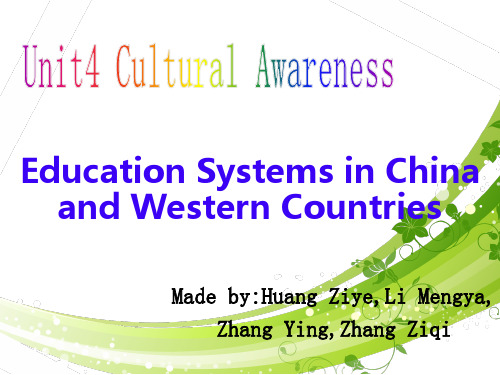
Orderly ,gentle person and “high scores” talents
SUCCESS
THANK YOU
2020/1/10
Western Education System
The Cultural Reason For Its Formation The Western Education Model The People Under Western Culture
Education Systems in China and Western Countries
Made by:Huang Ziye,Li Mengya, Zhang Ying,Zhang Ziqi
Cultural Background
Education under Chinese Culture
creative:from the quantity of the Noble Prize open:from the daily life
Western Education System Chinese Education System
Advantages and Disadvantages
Ability of Practice
Advantages and disadvantages
Sense of worth
Sense of belonging Tendency of interpersonal interaction
Ancient Times
Nowadays
Reason
Model
People Chinese education Western education
Education under Western Culture
中西方家庭教育差异英文 ppt课件
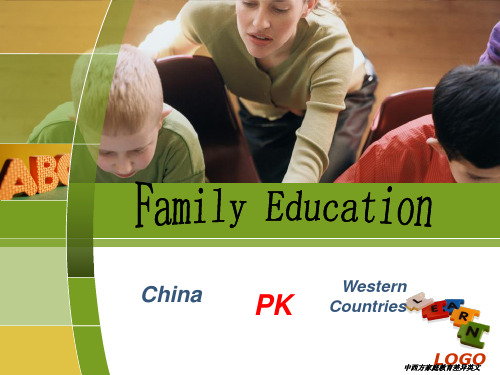
Main problems in today’s family education
methods
social systems education aims
Chinese family education and Western family education have their own characteristics.
Different from Chinese family education, Ameirican indulgent type of family education had more harmful effection. Because over indulgent, it made a lot of social problems.Such as, teenage crime. In radio or TV, we sometimes can get a information that a 15-year-old boy shot his friend in the middle school.
中西方家庭教育差异英
Main problems in Western family education.
2. lack of communication
American think that every member in a family, he or she should had his or her own space. In their opinions, they can't interfere each other even they are in a family. And when a person is 18 years old, he may leave his parents. It means he has little time to stay with their parents. So they has less resposibility to their parents.
用英语比较中国和西方教育孩子的不同及教育孩子的建议

Education System
China
In China, the education system is often seen as highly competitive, with a strong emphasis on academic performance. Children are expected to excel academically, and success in the gaokao, the national college entrance exam, is paramount. This focus on grades often results in high-pressure environments for students, leading to stress and anxiety
Parenting Styles
Western Countries
Western parents tend to take a more permissive and collaborative approach. They often prioritize their children's happiness and self-expression, encouraging them to make their own decisions and fostering independent thinking. Western parents also place more emphasis on communication and open dialogue with their children
Child-rearing Advice
For Chinese Parents
中西方教育文化的差异英文版

The Difference Between Chinese AndWestern Educational Culture China VS Western尙〔.difference of familv educationDiffere nee2.difference of school education1Difference between china education and western educationEducation is not the preparation for making their living, but for survivalYr The education'sgoal is for making their living, for honor Emphasize" The Learn Education."ChinaWestern Countriesreputation ineducation the childCare about the凸China Education method匕1.Emphasize mechanical memorizi ng.2」f the book is readhundreds of times,its meaning isshown naturally^WesternCountries 魂1.Emphasize thechilcTs” power ofunderstanding." 樺2.Seeking theknowledge from lifeand nature.Education inFj Chinal.Earning money tosupport ongs familyand managing thewealth are adult's* matter.・Try every means to $ satisfy the children 1with money・managing money璋Western Countries# l.Teach the child take theplans for budget items,learn to spend moneyreas onably.弊2・Encourage the childto work outside to gain income by themselves.American children in class Chinese children in classDifferences of schooleducationThe relation between teachers andstudentsIn America teachers are no longer authority, meanwhile students don't have to carry out every instruction from their teachers, most of them have their thoughts, they may most questions and challenges toteachers・如n chin可the relaUonship between teachers and students can be quite formal.# We are taught since the first day when we go to the kindergarten that we should sit up straight and obey all the disciplines. in class we seldom challenge the teacher's ideas.Summary凸l.Westerners believe in individualism, and Chinese believe in collectivism.匕2.The western culture has the freedom to express affection freely,whereas the Chineseculture is puritanical.蜉3.The Chinese believe in relationships, and searching for inner bliss and happiness through meditation.鏗4.The western culture believes in a materialistic approach, and has a pragmatic and emotional attitude・。
中美教育差异 英文版

a
19
Middle School
• Often students go on school field trips
a
20
Middle School
• School might require a uniform • About 20% of schools in America have them
a
23
High School
• Students choose many different electives
• Art • Choir • Band • Cooking • Acting • Driver’s Education
a
24
High School - Sports
• Boys – American Football
a
21
High School
a
22
High School
• Students learn advanced subjects like math, science, history, economics, speech, music and art
• Each student has his own schedule and moves to different classrooms for each class
a
49
University - Trips
• have a playdate • be in a school play • complain about not being in a school play • watch TV or play computer games • choose their own extracurricular activities • get any grade less than an A • not be the No. 1 student in every subject except gym and drama • play any instrument other than the piano or violin • not play the piano or violin.
中美教育差异--完整英文版PPT课件

.
46
University
.
47
University - Projects
• Universities attract the top scientists and doctors to be teachers
Education
.
1
Part 1. Chinese Education Part 2. American Education Part 3. The differences of education between China and America
.
2
.
3
• Chinese education is called examoriented education,which is focus on raising the children in taking the exams to gain more scores ,so as to check up how much the knowledge they have learnt and pick up the superiors.
.
8
American Education
.
9
American Schools
.
10
The American education system
Primary school
Secondary school
Undergraduate school
Graduate school
.
11
中西方教育体制差异英文PPT
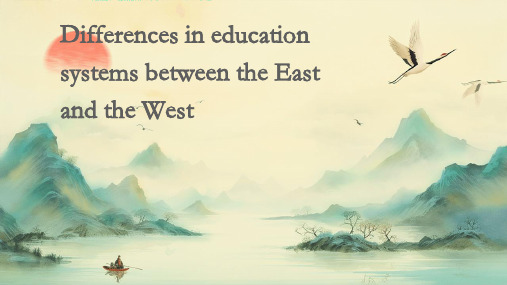
Differences in learning styles
Eastern style
More passive, teacher-centered, with students following the teacher's instructions and completing assigned work.
Western educational philosophy
Individualism
Prioritizes individual development, creativity, and critical thinking.
Problem-solving skills
Emphasizes the development of problem-solving, innovation, and practical skills.
03
Parental Involvement
Parents play a more active role in their children's education in the West, with more opportunities for input and feedback.
04
Flexibility
Disadvantages
02
Pressured Environment: The education system can be very competitive, leading to high stress levels for students.
03
Teacher-Focused: The teacher often dictates the pace and content of the learning.
中西方教育文化的差异英文版演示课件.ppt
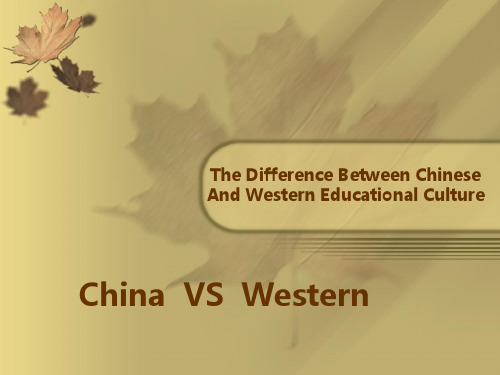
2.Try every means to satisfy the children with money.
2.Encourage the child to work outside to gain income by themselves.
Differences of school education
Western Countries
Education is not the preparation for making their living, but for survival
Emphasize" The Learn Education. "
Education method
China
1.Emphasize mechanical memorizing.
Summary
1.Westerners believe in individualism, and Chinese believe in collectivism. 2.The western culture has the freedom to express affection freely ,whereas the Chinese culture is puritanical. 3.The Chinese believe in relationships, and searching for inner bliss and happiness through meditation. 4.The western culture believes in a materialistic approach, and has a pragmatic and emotional attitude.
中西方教育体制差异英文PPT演示课件.ppt
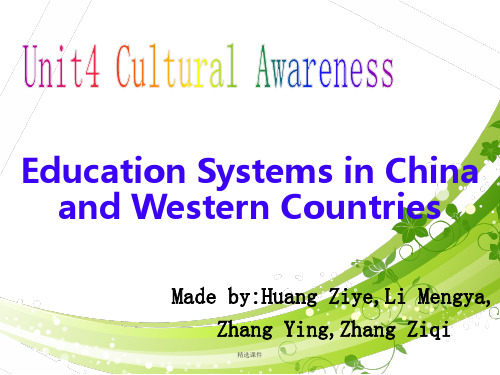
Education Under
Chinese Culture
Favorable or unfavorable?
精选课件
Ancient Times--Drawbacks
Four Books
and Five
Classics
Confucian culture
Eight-part
Limited thinking
Underage
student crime
case
精选课件
Creativity Independence
精选课件
Education Systems in China and
Western Countries
Cultural Background
Education under Chinese Culture
Reason
Model
People Chinese education Western education
Thank you
精选课件
Open :The western education is affected heavily by its commercial culture .
精选课件
In the classroom(greeting to teachers,asking questions,problemsolving approach)
Only books; the only authority of the traditional style of study.
Lack of innovation ability
Action imprisoned
Lack of practical ability
中西方教育差异(英文)PPT课件
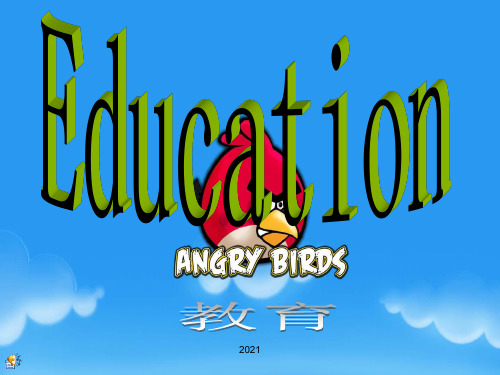
The focus of family education
IN CHINA:
Parents pay attention to the cultivation of moral (父母注意培养道德)
In western countries:
Parents pay attention to children's curiosity and imagination of nature. (父母关注孩子的好奇心和想象力的性质。)
In western countries:
InspiriΒιβλιοθήκη g the children to get the money through their own efforts. (激发孩子,赚钱通过自己202的1 努力。)
China and Western countries in common 1、(Parents all pay attention to home education.
2021
The training of sense of independence
IN CHINA:
Learning is the most important thing that children should care about. (学习是最重要的孩子们应该关心的事情。)
In western countries:
2021
• 1、The tendency of family education (家庭教育的趋势)
• 2、The values of family education (家庭教育价值观)
• 3、The focus of family education (家庭教育的重心)
中国教育与西方教育的对比 全英文PPT
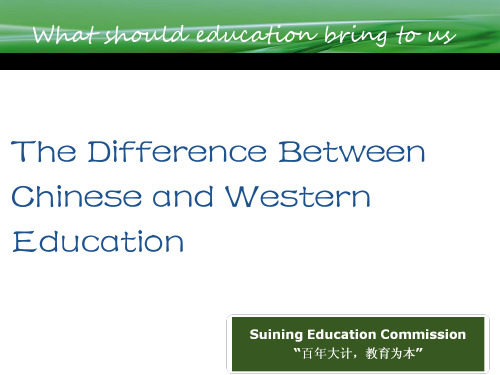
What should education bring to us
Methods of Education
Education system in China Education problems in China Differences
System? Problems? Differences!
video
What should education bring to us
Conclusion:
Compared with western countries, the education in China is more traditional and more systematic(系统的 ) and it is better for the children's intelligence development. Training and education for many years also can enable the student to have the collective consciousness(集体意识), the strong sense of responsibility and discipline(强烈的责任感和自律 ).
Family In China
In the child’s growth process, parents are most concerned about children’s learning. To make the children get good grades ,the parents don’t let the children do anything .
What should education bring to us
中西方课堂的差异英语作文
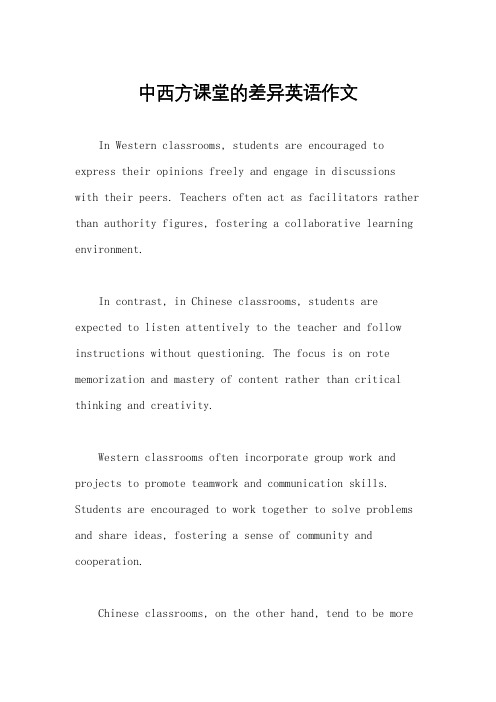
中西方课堂的差异英语作文In Western classrooms, students are encouraged to express their opinions freely and engage in discussions with their peers. Teachers often act as facilitators rather than authority figures, fostering a collaborative learning environment.In contrast, in Chinese classrooms, students are expected to listen attentively to the teacher and follow instructions without questioning. The focus is on rote memorization and mastery of content rather than critical thinking and creativity.Western classrooms often incorporate group work and projects to promote teamwork and communication skills. Students are encouraged to work together to solve problems and share ideas, fostering a sense of community and cooperation.Chinese classrooms, on the other hand, tend to be moreteacher-centered, with the teacher delivering lectures and students taking notes. There is less emphasis on collaboration and more on individual achievement and performance.In Western classrooms, assessment is often based on a variety of methods, including presentations, essays, and projects. Students are evaluated on their understanding of concepts and ability to apply them in real-world situations.In Chinese classrooms, assessment is typically based on exams and standardized tests. Students are expected to memorize information and perform well on tests to demonstrate their knowledge and understanding of the material.Overall, the differences between Western and Chinese classrooms reflect broader cultural values and educational philosophies. Western education tends to prioritizecritical thinking, creativity, and collaboration, while Chinese education emphasizes discipline, hard work, and academic achievement.。
中西方课堂的差异英语作文

中西方课堂的差异英语作文In Western classrooms, students are encouraged to express their opinions freely. They are often given the opportunity to engage in open discussions and debates, allowing them to develop critical thinking skills. This promotes a more interactive and dynamic learning environment.On the other hand, in Chinese classrooms, the emphasis is often on rote memorization and following instructions. Students are expected to listen attentively to the teacher and take notes. This traditional teaching method focuses more on the accumulation of knowledge rather than on fostering independent thinking.In Western classrooms, teachers often use various teaching aids and multimedia resources to make the learning process more engaging and interactive. They may use videos, PowerPoint presentations, or online resources to supplement their lectures. This helps to capture students' attentionand enhance their understanding of the subject matter.In Chinese classrooms, the use of teaching aids is less common. Teachers mainly rely on textbooks and chalkboards to deliver their lessons. This traditional approach may be seen as more disciplined and structured, but it may also limit students' creativity and critical thinking abilities.In Western classrooms, students are encouraged to ask questions and seek clarification if they do not understand something. This promotes active learning and helps students to develop a deeper understanding of the subject matter. Teachers are seen as facilitators of learning, rather than the sole source of knowledge.In Chinese classrooms, students are often hesitant to ask questions, as they may be seen as challenging the teacher's authority. The teacher is considered the ultimate authority figure, and students are expected to listen and obey without questioning. This can hinder students' ability to think critically and actively participate in the learning process.In Western classrooms, group work and collaborative projects are often encouraged. Students are given the opportunity to work together, share ideas, and learn from their peers. This promotes teamwork and helps students to develop important social skills.In Chinese classrooms, group work is less common. Students are often expected to work individually and compete against each other academically. This may foster a more competitive environment but may also hinder students' ability to collaborate and communicate effectively with others.Overall, the differences between Western and Chinese classrooms reflect cultural and educational traditions. While Western classrooms focus on fostering critical thinking, independence, and active learning, Chinese classrooms emphasize discipline, rote memorization, and respect for authority. Both approaches have their merits, but it is important to recognize and appreciate the diversity in teaching methods and learning styles.。
中西方教育体制差异英文
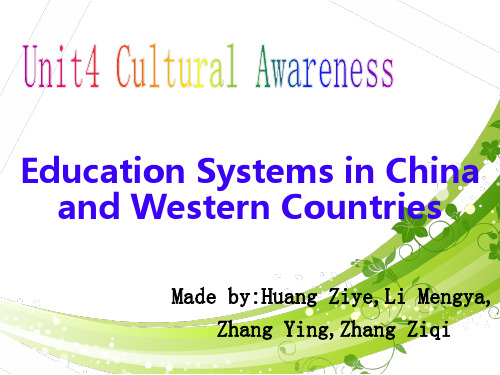
Made by:Huang Ziye,Li Mengya, Zhang Ying,Zhang Ziqi
Cultural Background
Education under Chinese Culture
Sense of Worth
Collectivism
lism
Sense of Belonging
Tendency of Interpersonal Interaction
Low down Ourselves Raise Others
Equalitarianism
Education Under
Individualism:In western countries,independent thinking is highly valued.
Open :The western education is affected heavily by its commercial culture .
In the classroom(greeting to teachers,asking questions,problemsolving approach)
Chinese Culture
Favorable or unfavorable?
Ancient Times--Drawbacks
Four Books
and Five
Classics
Confucian culture
Eight-part
Limited thinking
essays
Ancient Times--Benefits
- 1、下载文档前请自行甄别文档内容的完整性,平台不提供额外的编辑、内容补充、找答案等附加服务。
- 2、"仅部分预览"的文档,不可在线预览部分如存在完整性等问题,可反馈申请退款(可完整预览的文档不适用该条件!)。
- 3、如文档侵犯您的权益,请联系客服反馈,我们会尽快为您处理(人工客服工作时间:9:00-18:30)。
education
Thank you
23
creative:from the quantity of the Noble Prize
open:from the daily life
16
Western Education System Chinese Education System
Advantages and Disadvantages
17
case 20
Creativity Independence
21
Education SyHale Waihona Puke tems in China and
Western Countries
Cultural Background
Education under Chinese Culture
Education under Western Culture
Chinese Culture
Favorable or unfavorable?
8
Ancient Times--Drawbacks
Four Books and Five Classics
Confucian culture
Eight-part essays
Limited thinking
9
Ancient Times--Benefits
13
Individualism:In western countries,independent thinking is highly valued.
Open :The western education is affected heavily by its commercial culture .
Lack of innovation ability
Action imprisoned
Lack of practical ability
11
Nowadays--advantages
Strict educational framework and tight schedule
San Zi Jing Human based idea Have both ability and political integrity
Imperial Examination System and Social Relations culture
Diligent
Modest and Studious
Well-read and Elegant
10
Nowadays--disadvantages
Only books; the only authority of the traditional style of study.
4
Sense of Worth
Collectivism
Individualism
5
Sense of Belonging
6
Tendency of Interpersonal Interaction
Low down Ourselves Raise Others
Equalitarianism
7
Education Under
Education Systems in China and Western Countries
Made by:Huang Ziye,Li Mengya, Zhang Ying,Zhang Ziqi
1
Cultural Background
Education under Chinese Culture
Ability of Practice
Ability of Creation
Adapting to the Society
18
The lack of basic knowledge The lack of collectivism
19
Imitative ability
Basic skills
Underage student crime
Advantages and disadvantages
Sense of worth
Sense of belonging Tendency of interpersonal interaction
Ancient Times
Nowadays
Reason
Model
People Chinese education Western
Education under Western Culture
Advantages and Disadvantages
Western Culture
2
Education reflects culture.
3
Sense of Worth Sense of Belonging Tendency of Interpersonal Interaction
Orderly ,gentle person and “high scores” talents
12
Western Education System
The Cultural Reason For Its Formation The Western Education Model The People Under Western Culture
14
In the classroom(greeting to teachers,asking questions,problemsolving approach)
Homework:diverse and practical
15
This kind of education system can create low-score and high-capacity person.So the western students are usually creative and open.
